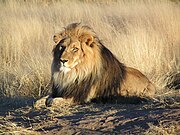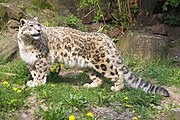Pantherinae
| Pantherinae[1] Temporal range: | |
|---|---|
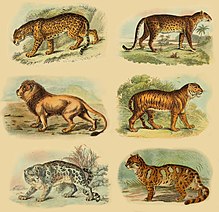 | |
| Pantherinae subfamily members (from left): jaguar, leopard, lion, tiger, snow leopard and clouded leopard | |
| Scientific classification | |
| Domain: | Eukaryota |
| Kingdom: | Animalia |
| Phylum: | Chordata |
| Class: | Mammalia |
| Order: | Carnivora |
| Suborder: | Feliformia |
| Family: | Felidae |
| Subfamily: | Pantherinae Pocock, 1917 |
| Genera | |
| |
The Pantherinae is a subfamily of the Felidae; it was named and first described by Reginald Innes Pocock in 1917 as only including the Panthera species.[2] The Pantherinae genetically diverged from a common ancestor between 9.32 to 4.47 million years ago and 10.67 to 3.76 million years ago.[3][4]
Characteristics[edit]
Pantherinae species are characterised by an imperfectly ossified hyoid bone with elastic tendons that enable their larynx to be mobile.[2] They have a flat rhinarium that only barely reaches the dorsal side of the nose. The area between the nostrils is narrow, and not extended sidewards as in the Felinae.[5]
The Panthera species have a single, rounded, vocal fold with a thick mucosal lining, a large vocalis muscle, and a large cricothyroid muscle with long and narrow membranes. A vocal fold that is longer than 19 mm (0.75 in) enables all but the snow leopard among them to roar, as it has shorter vocal folds of 9 mm (0.35 in) that provide a lower resistance to airflow; this distinction was one reason it was proposed to be retained in the genus Uncia.[6][7]
Evolution[edit]
The Felidae originated in Central Asia in the Late Miocene; the subfamily Pantherinae diverged from the Felidae between 14.45 to 8.38 million years ago and 16.35 to 7.91 million years ago.[3][4] Several fossil Panthera species were described:
- Panthera blytheae is the oldest known species that possibly lived about 5.95 to 4.1 million years ago.[8]
- Panthera palaeosinensis lived in the early Pleistocene around two to three million years ago in northern East Asia.[9]
- Panthera zdanskyi is dated to 2.55 to 2.16 million years ago.[9]
- Panthera gombaszoegensis lived from about 2 to 0.35 million years ago in Europe.[10]
- Panthera youngi lived in the Pleistocene about 0.69 to 0.42 million years ago in China.[11]
- Panthera spelaea lived in Europe after the third Cromerian interglacial stage from about 450,000 to 14,000 years ago.[12]
- Panthera atrox lived in North America during the Pleistocene and early Holocene about 340,000 to 11,000 years ago.[13]
- Panthera shawi was a lion-like cat in South Africa that possibly lived in the early Pleistocene.[14]
- Panthera balamoides lived in the Yucatan Peninsula in Mexico, during the Pleistocene.[15]
An additional fossil genus Leontoceryx was described in 1938.[16]
There is evidence of distinct markers for the mitochondrial genome for Felidae.[17][18]
Results of a DNA-based study indicate that the tiger (Panthera tigris) branched off first, followed by the jaguar (P. onca), the lion (P. leo), then the leopard (P. pardus) and snow leopard (P. uncia).[19]
Felis pamiri, formerly referred to as Metailurus, is now considered a probable relative of extant Pantherinae and was moved to the genus Miopanthera.[20]
Taxonomy[edit]
Pocock originally defined the Pantherinae as comprising the genera Panthera and Uncia.[2] Today, Uncia has been subsumed into Panthera, and the genus Neofelis is also included.[21]
Living genera[edit]
The following table shows the extant taxa within the Pantherinae, grouped according to the traditional phenotypical classification.[21]
| Common name | Scientific name and subspecies | Range | Size and ecology | IUCN status and estimated population |
|---|---|---|---|---|
| Clouded leopard | N. nebulosa (Griffith, 1821) | Central Nepal to continental Southeast Asia and southern China | Size: head to body 68.6–108 cm (27.0–42.5 in) with 61–91 cm (24–36 in) long tail[22] Habitat: Forest and shrubland[23] Diet: Medium-sized and small mammals on the ground and in trees, as well as birds[23] | VU
|
| Sunda clouded leopard | N. diardi Cuvier, 1823 Two subspecies
| Parts of Sumatra and Borneo | Size: 69–108 cm (27–43 in) long, 61–91 cm (24–36 in) tail[24] Habitat: Forest[25] Diet: Medium-sized and small mammals[25] | VU
|
| Common name | Scientific name and subspecies | Range | Size and ecology | IUCN status and estimated population |
|---|---|---|---|---|
| Jaguar | P. onca (Linnaeus, 1758) | Large swathes of South and Latin America, and Arizona in the United States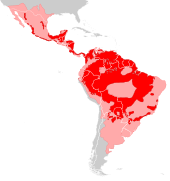 | Size: 110–170 cm (43–67 in) long, 44–80 cm (17–31 in) tail[26] Habitat: Forest, shrubland, inland wetlands, savanna, and grassland[27] Diet: Variety of mammals, reptiles and birds, preferring ungulates[27] | NT
|
| Leopard | P. pardus (Linnaeus, 1758) Eight subspecies
| Much of Sub-Saharan Africa, the Middle East, the Indian subcontinent, the Caucasus in Europe, Southeast Asia, and Siberia | Size: 91–191 cm (36–75 in) long, 51–101 cm (20–40 in) tail[28] Habitat: Forest, desert, rocky areas, grassland, savanna, and shrubland[29] Diet: Ungulates, as well as other mammals, insects, reptiles, and birds[29] | VU
|
| Lion | P. leo (Linnaeus, 1758) Two subspecies | Sub-Saharan Africa and India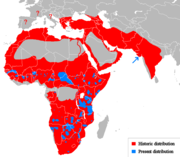 | Size: 137–250 cm (54–98 in) long, 60–100 cm (24–39 in) tail[30] Habitat: Forest, grassland, shrubland, savanna, and desert[31] Diet: Ungulates such as antelopes, zebra, and wildebeest, as well as other small to large mammals[31] | VU
|
| Snow leopard | P. uncia (Schreber, 1775) | Himalayas reaching north to Mongolia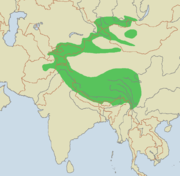 | Size: 90–120 cm (35–47 in) long, 80–100 cm (31–39 in) tail[32] Habitat: Shrubland, rocky areas, forest, and grassland[33] Diet: Caprids such as sheep and goats, as well as small mammals and birds[33] | VU
|
| Tiger | P. tigris (Linnaeus, 1758) Two subspecies
| Scattered sections of Southeast Asia, Indian subcontinent, and Siberia | Size: 150–230 cm (59–91 in) long, 90–110 cm (35–43 in) tail[34] Habitat: Shrubland, forest, and grassland[35] Diet: Deer and wild pigs, as well as a wide variety of other animals[35] | EN
|
See also[edit]
References[edit]
- ^ Wozencraft, W. C. (2005). "Pantherinae". In Wilson, D. E.; Reeder, D. M. (eds.). Mammal Species of the World: A Taxonomic and Geographic Reference (3rd ed.). Johns Hopkins University Press. pp. 545–548. ISBN 978-0-8018-8221-0. OCLC 62265494.
- ^ a b c Pocock, R. I. (1917). "The Classification of existing Felidae". The Annals and Magazine of Natural History. Series 8. XX: 329–350. doi:10.1080/00222931709487018.
- ^ a b Johnson, W. E.; Eizirik, E.; Pecon-Slattery, J.; Murphy, W. J.; Antunes, A.; Teeling, E. & O'Brien, S. J. (2006). "The late Miocene radiation of modern Felidae: a genetic assessment". Science. 311 (5757): 73–77. Bibcode:2006Sci...311...73J. doi:10.1126/science.1122277. PMID 16400146. S2CID 41672825.
- ^ a b Li, G.; Davis, B. W.; Eizirik, E. & Murphy, W. J. (2016). "Phylogenomic evidence for ancient hybridization in the genomes of living cats (Felidae)". Genome Research. 26 (1): 1–11. doi:10.1101/gr.186668.114. PMC 4691742. PMID 26518481.
- ^ Hemmer, H. (1966). "Untersuchungen zur Stammesgeschichte der Pantherkatzen (Pantherinae). Teil I" [Researching the phylogenetic history of the Pantherinae. Part I]. Veröffentlichungen der Zoologischen Staatssammlung München. 11: 1–121.
- ^ Hast, M. H. (1989). "The larynx of roaring and non-roaring cats". Journal of Anatomy. 163: 117–121. PMC 1256521. PMID 2606766.
- ^ Weissengruber, G. E.; Forstenpointner, G.; Peters, G.; Kübber-Heiss, A.; Fitch, W. T. (2002). "Hyoid apparatus and pharynx in the lion (Panthera leo), jaguar (Panthera onca), tiger (Panthera tigris), cheetah (Acinonyx jubatus) and domestic cat (Felis silvestris f. catus)". Journal of Anatomy. 201 (3): 195–209. doi:10.1046/j.1469-7580.2002.00088.x. PMC 1570911. PMID 12363272.
- ^ Tseng, Z.J.; Wang, X.; Slater, G.J.; Takeuchi, G.T.; Li, Q.; Liu, J. & Xie, G. (2014). "Himalayan fossils of the oldest known pantherine establish ancient origin of big cats". Proceedings of the Royal Society B: Biological Sciences. 281 (1774): 20132686. doi:10.1098/rspb.2013.2686. PMC 3843846. PMID 24225466.
- ^ a b Mazák, J. H.; Christiansen, P. & Kitchener, A. C. (2011). "Oldest Known Pantherine Skull and Evolution of the Tiger". PLOS ONE. 6 (10): e25483. Bibcode:2011PLoSO...625483M. doi:10.1371/journal.pone.0025483. PMC 3189913. PMID 22016768.
- ^ Marciszak, A. (2014). "Presence of Panthera gombaszoegensis (Kretzoi, 1938) in the late Middle Pleistocene of Biśnik Cave, Poland, with an overview of Eurasian jaguar size variability". Quaternary International. 326–327: 105–113. Bibcode:2014QuInt.326..105M. doi:10.1016/j.quaint.2013.12.029.
- ^ Sotnikova, M.V. & Foronova, I.V. (2014). "First Asian record of Panthera (Leo) fossilis (Mammalia, Carnivora, Felidae) in the Early Pleistocene of Western Siberia, Russia". Integrative Zoology. 9 (4): 517–530. doi:10.1111/1749-4877.12082. PMID 24382145.
- ^ Burger, J.; Rosendahl, W.; Loreille, O.; Hemmer, H.; Eriksson, T.; Götherström, A.; Hiller, J.; Collins, M. J.; Wess, T. & Alt, K. W. (2004). "Molecular phylogeny of the extinct cave lion Panthera leo spelaea". Molecular Phylogenetics and Evolution. 30 (3): 841–849. doi:10.1016/j.ympev.2003.07.020. PMID 15012963.
- ^ Christiansen, P. & Harris, J. M. (2009). "Craniomandibular morphology and phylogenetic affinities of Panthera atrox: implications for the evolution and paleobiology of the lion lineage". Journal of Vertebrate Paleontology. 29 (3): 934–945. doi:10.1671/039.029.0314. S2CID 85975640.
- ^ Sabol, M. (2011). "Masters of the lost world: a hypothetical look at the temporal and spatial distribution of lion-like felids". Quaternaire. Hors-série. 4: 229–236.
- ^ Stinnesbeck, S. R.; Stinnesbeck, W.; Frey, E.; Avilés Olguín, J.; Rojas Sandoval, C.; Velázquez Morlet, A.; González, A. H. (2019). "Panthera balamoides and other Pleistocene felids from the submerged caves of Tulum, Quintana Roo, Mexico". Historical Biology: An International Journal of Paleobiology. 32 (7): 930–939. doi:10.1080/08912963.2018.1556649. S2CID 92328512.
- ^ Kretzoi, M. (1938). "Die Raubtiere von Gombaszo ̈g nebst einer Ubersicht der Gesamtfauna". Annales Musei Nationalis Hungarici. 3.
- ^ Wei, L.; Wu, X. & Jiang, Z. (2008). "The complete mitochondrial genome structure of snow leopard Panthera uncia". Molecular Biology Reports. 36 (5): 871–878. doi:10.1007/s11033-008-9257-9. PMID 18431688. S2CID 22736941.
- ^ Yu, L.; Qing-wei, L.; Ryder, O.A. & Ya-ping, Z. (2004). "Phylogenetic relationships within mammalian order Carnivora indicated by sequences of two nuclear DNA genes" (PDF). Molecular Phylogenetics and Evolution. 33 (3): 694–705. doi:10.1016/j.ympev.2004.08.001. PMID 15522797. Archived from the original (PDF) on 2011-07-07.
- ^ Yu, L.; Zhang, Y. P. (2005). "Phylogenetic studies of pantherine cats (Felidae) based on multiple genes, with novel application of nuclear beta fibrinogen intron 7 to carnivores". Molecular Phylogenetics and Evolution. 35 (2): 483–495. doi:10.1016/j.ympev.2005.01.017. PMID 15804417.
- ^ Geraads, D.; Peigné, S. (2016). "Re-Appraisal of Felis pamiri Ozansoy, 1959 (Carnivora, Felidae) from the Upper Miocene of Turkey: the Earliest Pantherine Cat?". Journal of Mammalian Evolution. 24 (4): 415–425. doi:10.1007/s10914-016-9349-6. S2CID 207195894.
- ^ a b Kitchener, A. C.; Breitenmoser-Würsten, C.; Eizirik, E.; Gentry, A.; Werdelin, L.; Wilting, A.; Yamaguchi, N.; Abramov, A. V.; Christiansen, P.; Driscoll, C.; Duckworth, J. W.; Johnson, W.; Luo, S.-J.; Meijaard, E.; O’Donoghue, P.; Sanderson, J.; Seymour, K.; Bruford, M.; Groves, C.; Hoffmann, M.; Nowell, K.; Timmons, Z.; Tobe, S. (2017). "A revised taxonomy of the Felidae: The final report of the Cat Classification Task Force of the IUCN Cat Specialist Group" (PDF). Cat News (Special Issue 11): 64−75.
- ^ Sunquist, M. & Sunquist, F. (2002). "Clouded leopard Neofelis nebulosa (Griffiths, 1821)". Wild cats of the World. Chicago: University of Chicago Press. pp. 278–284. ISBN 978-0-226-77999-7.
- ^ a b c Gray, T.; Borah, J.; Coudrat, C. N. Z.; Ghimirey, Y.; Giordano, A.; Greenspan, E.; Petersen, W.; Rostro-García, S.; Shariff, M.; Wai-Ming, W. (2021). "Neofelis nebulosa". IUCN Red List of Threatened Species. 2021: e.T14519A198843258. doi:10.2305/IUCN.UK.2021-2.RLTS.T14519A198843258.en.
- ^ "CatSG: Sunda clouded leopard". International Union for Conservation of Nature Cat Specialist Group. Archived from the original on July 25, 2018. Retrieved March 25, 2019.
- ^ a b c Hearn, A.; Ross, J.; Brodie, J.; Cheyne, S.; Haidir, I. A.; Loken, B.; Mathai, J.; Wilting, A.; McCarthy, J. (2016). "Neofelis diardi". IUCN Red List of Threatened Species. 2015: e.T136603A50664601. doi:10.2305/IUCN.UK.2015-4.RLTS.T136603A50664601.en.
- ^ "CatSG: Jaguar". International Union for Conservation of Nature Cat Specialist Group. Archived from the original on March 7, 2015. Retrieved March 25, 2019.
- ^ a b c Quigley, H.; Foster, R.; Petracca, L.; Payan, E.; Salom, R.; Harmsen, B. (2018). "Panthera onca". IUCN Red List of Threatened Species. 2017: e.T15953A50658693. doi:10.2305/IUCN.UK.2017-3.RLTS.T15953A50658693.en.
- ^ "CatSG: Leopard". International Union for Conservation of Nature Cat Specialist Group. Archived from the original on June 23, 2018. Retrieved March 25, 2019.
- ^ a b c Stein, A. B.; Athreya, V.; Gerngross, P.; Balme, G.; Henschel, P.; Karanth, U.; Miquelle, D.; Rostro-Garcia, S.; Kamler, J. F.; Laguardia, A.; Khorozyan, I.; Ghoddousi, A. (2016). "Panthera pardus". IUCN Red List of Threatened Species. 2016: e.T15954A50659089. doi:10.2305/IUCN.UK.2016-1.RLTS.T15954A50659089.en.
- ^ "CatSG: African lion". International Union for Conservation of Nature Cat Specialist Group. Archived from the original on December 11, 2014. Retrieved March 25, 2019.
- ^ a b c Bauer, H.; Packer, C.; Funston, P. F.; Henschel, P.; Nowell, K. (2017). "Panthera leo". IUCN Red List of Threatened Species. 2016: e.T15951A107265605. doi:10.2305/IUCN.UK.2016-3.RLTS.T15951A107265605.en.
- ^ "CatSG: Snow leopard". International Union for Conservation of Nature Cat Specialist Group. Archived from the original on March 18, 2018. Retrieved March 25, 2019.
- ^ a b c McCarthy, T.; Mallon, D.; Jackson, R.; Zahler, P.; McCarthy, K. (2017). "Panthera uncia". IUCN Red List of Threatened Species. 2017: e.T22732A50664030. doi:10.2305/IUCN.UK.2017-2.RLTS.T22732A50664030.en.
- ^ "CatSG: Tiger". International Union for Conservation of Nature Cat Specialist Group. Archived from the original on November 12, 2014. Retrieved March 25, 2019.
- ^ a b c Goodrich, J.; Lynam, A.; Miquelle, D.; Wibisono, H.; Kawanishi, K.; Pattanavibool, A.; Htun, S.; Tempa, T.; Karki, J.; Jhala, Y.; Karanth, U. (2015). "Panthera tigris". IUCN Red List of Threatened Species. 2015: e.T15955A50659951. doi:10.2305/IUCN.UK.2015-2.RLTS.T15955A50659951.en.
External links[edit]
- Choi, C. Q. (2011). "World's Oldest Tiger Species Discovered". Live Science. Retrieved 2019-06-30.


 French
French Deutsch
Deutsch



